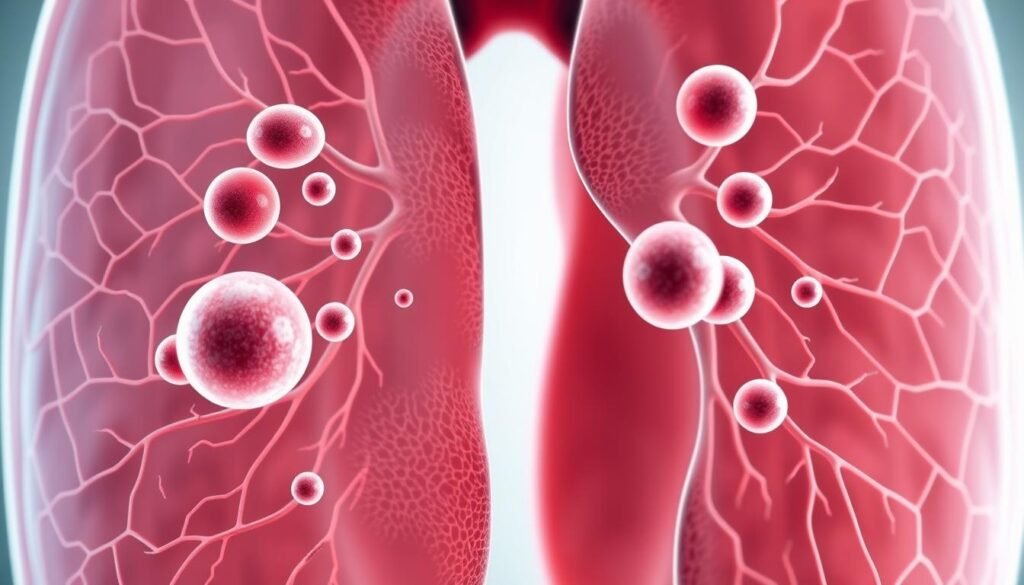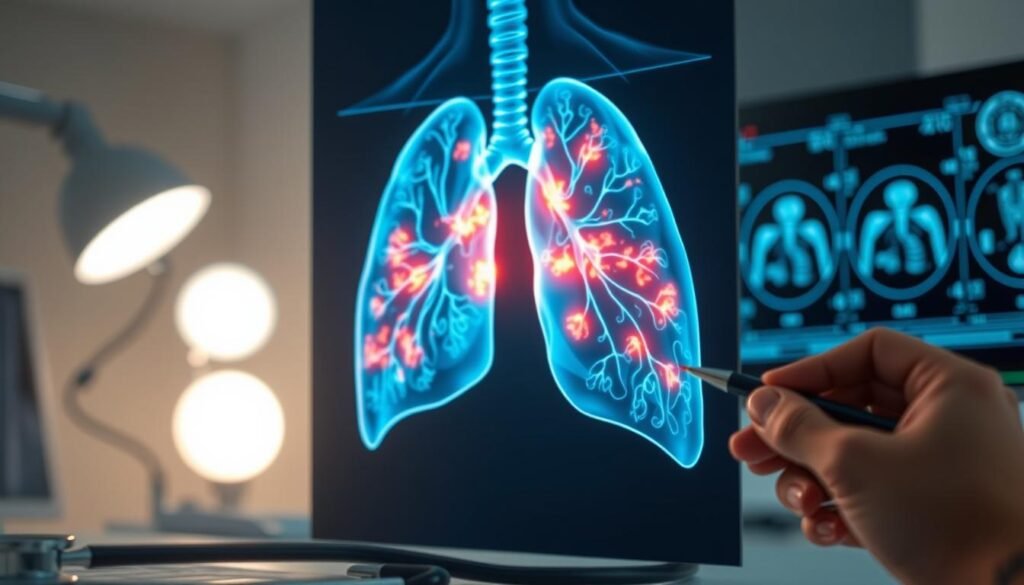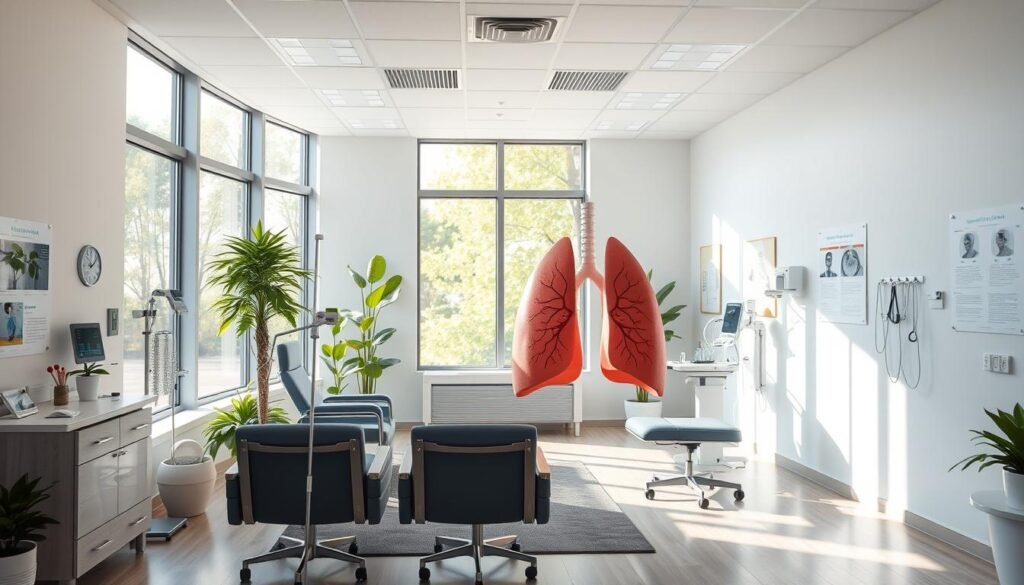About four in ten people with lung cancer show signs only when it’s advanced. It’s very important to notice the early signs of lung cancer. Many times, people ignore these signs because they don’t seem serious. Spotting lung cancer early means you can get treated sooner. This makes the treatment more likely to succeed.
Lung cancer might start by showing small signs. These include a cough that won’t go away, losing weight without trying, and chest pain that gets worse when you breathe or cough. However, these symptoms are often missed. This can allow the cancer to grow undetected. That’s why knowing and acting on these signs can save lives. Let’s look at the early symptoms of lung cancer. This could help catch it early when treatment works best.
Key Takeaways
- Early lung cancer may not show symptoms until it has progressed significantly.
- A persistent cough and unexplained weight loss can be key lung cancer signs.
- Recognizing symptoms early can lead to more effective treatment options.
- Understanding risk factors is essential in preventing lung cancer.
- Multidisciplinary care teams enhance treatment efficacy in lung cancer patients.
Understanding Lung Cancer
Lung cancer starts when cells in the lungs grow out of control. It’s the third most common cancer in the U.S. after breast and prostate cancer. Each year, about 235,000 Americans are told they have lung cancer. And now, more than 611,000 people are living with it in the U.S.
There are two main kinds of lung cancer. Non-small cell lung cancer (NSCLC) makes up 85% to 90% of cases. It has types like squamous cell carcinoma, large cell carcinoma, and adenocarcinoma. Small cell lung cancer (SCLC) is about 10% to 15% of cases and is mostly seen in heavy smokers.
Knowing the stage of lung cancer is key for treatment. Staging looks at tumor size, if it has reached lymph nodes, or spread to other organs. Finding lung cancer early can save lives. In fact, people found to have early-stage lung cancer have a survival rate over 90%.
To learn about early signs of lung cancer, check out this resource. Knowing what symptoms to look for helps catch it early.
What is Early Lung Cancer?
Early lung cancer is when the disease is first found, and it’s still in the lungs. Knowing the stages of lung cancer is key. It decides how to treat it and the survival chances. Many people ignore early signs or think they are not serious.
About 90% of lung cancers are non-small-cell lung cancer (NSCLC). The treatment plan for Stage I, the first stage, is crucial. This stage can often be cured. More than 65% of people live at least five years after they’re diagnosed. Stage I is divided into IA and IB, based on the tumor size and spread. For example, stage IA1 has a survival rate of about 92%, but it’s 68% for stage IB.
Early lung cancer usually means stages 1, 2, and 3A for NSCLC, and limited-stage for small cell lung cancer (SCLC). Finding cancer early is important. If caught and treated early, 80% to 90% of cases can be cured. This shows why screenings and doctor visits are vital, especially for smokers.
To sum up, catching lung cancer early is a chance for better treatment results. Knowing the stages and finding cancer early can save lives.
Common Signs of Early Lung Cancer
Spotting lung cancer signs early can really improve treatment results. Even small signs should not be ignored. Look out for these early symptoms:
- Persistent coughing that sticks around or gets worse.
- Unexplained weight loss or not feeling hungry could mean something serious.
- Chest pain, especially when you laugh, cough, or breathe deeply.
- Shortness of breath, happening during normal activities or even while resting.
- Getting sick often with respiratory infections could point to lung problems.
Some symptoms specifically suggest lung issues. For example, around 80% of people with finger clubbing might have lung cancer. Anemia is common in lung cancer patients too, making them feel tired because they’re not getting enough oxygen.
Knowing these signs can lead to early discovery. If you notice these lung cancer signs, seeing a doctor is key. They can check for lung nodules or other serious signs. Learning about lung cancer symptoms is important for your health. For more info, visit the Mayo Clinic website.
Being aware of these symptoms allows people to seek care quickly. This is crucial for a good outcome.
Symptoms to Watch For
Knowing the early signs of lung cancer is crucial for prompt action. People should watch out for various signs. These signs can look like symptoms of minor illnesses.
Persistent Cough
A cough that stays and doesn’t get better can signal lung cancer. It’s often joined by symptoms like chest pain that gets worse when you breathe deeply. Don’t ignore a cough that suddenly starts or changes.
Chest Pain and Discomfort
Lung cancer may cause chest pain. This pain can get sharper when you breathe or cough. If you feel this way, see a doctor to get checked out properly.
Shortness of Breath
People with lung cancer may struggle to breathe easily. This trouble breathing can happen during everyday tasks. If breathing feels tough, it’s important to get checked by a doctor quickly.
Weight Loss and Fatigue
Sudden weight loss of 10 pounds or more and ongoing fatigue could be warning signs. These symptoms mean the body might be fighting hard. If you notice major weight changes or feel tired all the time, it’s wise to seek help from a doctor. For more details on early symptoms of lung cancer, check out this informative article.
The Role of Low-Dose CT Screening
Low-dose CT screening is key for catching lung cancer early, especially in people at high risk. It’s recommended every year for those 50 to 80 who have smoked a lot over the years. This includes current smokers or those who quit in the last 15 years.
A pack-year means smoking a pack a day for a year. But, there are worries about wrong positives, too much diagnosing, and the small radiation risk from low-dose CT scans. Sometimes, it leads to unneeded treatments for patients without serious health problems.
People should keep getting scanned yearly until they are 81, quit smoking for 15 years, or can’t have surgery due to other health issues. Luckily, many insurance plans help cover the cost of these screenings. This helps at-risk people get screened without worrying about the price.
Even with its benefits, not many eligible Americans get this screening – only 5.8%. In places like California, it’s even lower, at just 1%. But, those who get screened lower their chance of dying from lung cancer by 20%.
Being aware and having access to screening is crucial for catching lung cancer early. Groups like the American Lung Association and the American College of Radiology offer information and support. Also, quitting smoking decreases lung cancer risk. For help quitting, visit smokefree.gov.
Identifying Lung Nodules
Lung nodules are often found during routine chest X-rays and CT scans. Up to half of adults getting these scans might have them. It’s vital to understand these nodules for early lung cancer detection, which can greatly improve outcomes.
About 95 percent of lung nodules are not cancer. But, their presence raises questions, especially for high-risk individuals. For these people, nodules bigger than 1 cm need more tests. A PET scan or biopsy can check if they are cancer.
If early-stage non-small cell lung cancer is just in a nodule, removing it can be a treatment. Monitoring nodules over time is key. Doctors might do CT scans every 6 to 12 months to see any changes.

Whether to biopsy a nodule depends on its cancer risk. The biopsy’s results then decide the next step, treatment, or watchful waiting. With good follow-up, doctors can catch and treat early lung cancer effectively.
| Finding | Statistic |
|---|---|
| Lung nodules detected in adults | Up to 50% |
| Percentage of nodules that are benign | 95% |
| Small cell lung cancer cases | 10-15% |
| Follow-up for nodule size (≥1 cm) | PET scan/biopsy recommended |
| Eligibility for lung screening | Aged 50-80, smoking history |
| Typical monitoring period for nodules | 6-12 months |
Being vigilant in identifying and keeping an eye on lung nodules helps improve patient health significantly. Early lung cancer detection is therefore a major focus in healthcare.
Risk Factors for Early Lung Cancer
Understanding early lung cancer risk factors is key to preventing it. Elements like smoking habits, environmental exposures, and genetics play big roles. These factors increase the chance of getting the disease. Knowing about them helps people live healthier and may push them to stop smoking.
Smoking and Tobacco Use
About 80% of lung cancer deaths link back to smoking. Smokers face a much higher lung cancer risk than non-smokers. Tobacco use clearly relates to early lung cancer, showing the need for quitting smoking. Secondhand smoke also matters, causing around 7,300 lung cancer cases each year. So, staying away from tobacco is crucial in lowering lung cancer risks.
Environmental Factors
Environment plays a big part in lung cancer risk. For example, radon gas is the second major cause of lung cancer in the U.S. Workers exposed to asbestos or harmful chemicals are at greater risk. Even though outdoor air pollution only causes 1% to 2% of deaths, it’s still dangerous. Workplace pollutants like diesel exhaust are also harmful. Trying to limit exposure to these substances can reduce lung cancer risk.
Genetic Predisposition
Genes matter in lung cancer risk, too. If lung cancer runs in the family, your risk might go up. This means genetics can make someone more likely to get the disease. Some gene mutations, like changes in the EGFR gene, appear in non-smokers with lung cancer. Knowing your family history helps in understanding your own risk.
Diagnosis and Testing for Early Lung Cancer
Finding lung cancer early is key to better health results. Many tests for lung cancer check if it’s there and how far it has spread. A chest X-ray often starts the search for lung issues. But CT scans are better at finding early lung tumors than X-rays.

There are more ways to look for lung cancer. MRI scans show if cancer has reached important areas like the brain and liver. PET scans, merged with CT, are great for understanding the stage of cancer and finding metastases. Bone scans help see if the cancer has moved to the bones.
- Fine needle aspiration (FNA) biopsy: collects tissue samples for analysis.
- Core needle biopsy (CNB): provides larger samples for more accurate diagnosis.
- Sputum cytology: analyzes mucus from the lungs to find cancer cells.
- Bronchoscopy: allows for direct visualization of airways and potential biopsy of discovered tumors.
- Thoracentesis: removes fluid around the lungs to test for cancer presence.
Looking closer, like with mediastinoscopy and thoracoscopy, helps see if cancer has spread around the lungs. Low-dose CT scans are suggested every year for those at high risk. This includes people over 50 who have smoked a lot.
Only 21% of lung cancers are found early. This shows how crucial lung cancer testing is. Knowing about these tests can help catch lung cancer early. This leads to better chances of successful treatment.
Importance of Early Detection
Finding lung cancer early is key to better outcomes. It leads to a good lung cancer prognosis. Catching it at the start improves chances for successful treatment. Sadly, few people who could benefit from screening actually get it done.
Many people live far from screening centers. Over 36% must travel over an hour for tests. Low-dose CT scans can lower lung cancer death rates by 20-25% compared to chest x-rays. Yet, not enough people get screened regularly.
Lung cancer is the top cause of cancer deaths in the U.S. It surpasses breast, prostate, and pancreatic cancers. Women and Black individuals face higher risks. Everyone aged 50 to 80 with a history of smoking should get yearly screenings.
Screening early is crucial because lung cancer doesn’t show symptoms early on. Low-dose CT scans can find small lung tumors early. If you’re at risk, seek screening early to fight lung cancer effectively.
Loyola Medicine in Chicago offers budget-friendly lung cancer screenings. Promoting awareness and accessibility is vital. It helps save lives through early detection, highlighting the big screening benefits.
| Screening Method | Death Risk Reduction | Typical Audience |
|---|---|---|
| Low-Dose CT Scan | 20-25% | Aged 50-80 with a smoking history |
| Chest X-ray | Limited | General population |
Treatment Options for Early Lung Cancer
Early lung cancer treatment has several options. Healthcare pros choose the best therapy based on each person’s situation. Surgery, radiation, and targeted therapy are key. These methods depend on the cancer’s stage and type, plus the patient’s health.
Surgery is the main way to treat early non-small cell lung cancer (NSCLC). For stage 0 NSCLC, surgery often works well alone. It might not need chemo or radiation. Operations like segmental resection or lobectomy remove the tumor and save lung function.
Radiation therapy is also common. It uses high-energy rays to kill cancer cells. Often, it’s combined with chemo for better results. For those needing more help, drugs like crizotinib target specific NSCLC types. This makes disease management efficient.
The following table outlines various treatment options based on the stages of lung cancer:
| Stage | Treatment Options |
|---|---|
| Stage 0 | Surgery alone; considerations for alternative treatments (photodynamic therapy, laser therapy, brachytherapy) |
| Stage II NSCLC | Neoadjuvant chemotherapy with or without immunotherapy |
| Stage IIIB | Chemoradiation (chemotherapy combined with radiation therapy) |
| Stage IV | Varied options including surgery, chemotherapy, targeted therapy, immunotherapy, and radiation therapy based on health and cancer spread |
For advanced stages, immunotherapy is a key hope. It’s great for cancers with lots of PD-L1 protein. This treatment wakes up the body’s immune system to fight cancer.
Picking the right treatment requires teamwork. Patients and doctors must work together. A plan that looks at tumor traits and the patient’s health can really help.

Conclusion
Knowing the early signs of lung cancer is key to better outcomes. Awareness can push for quick action, helping save lives. The use of low-dose CT scans has changed how we detect lung cancer early, improving chances of survival. People at risk should get screened and talk to their doctors about any worrying signs.
Lung cancer is still a top cause of cancer deaths, so staying alert to body changes is vital. With proper knowledge and healthcare access, we can see better results for lung cancer patients. To learn more about lung cancer’s current state, including efforts to fix diagnosis and treatment gaps, check out the key findings from reputable sources.
Rising awareness, early detection, and better treatments are key to fighting lung cancer. Everyone should keep an eye on their lung health. These steps could lead to higher survival rates and better health overall.